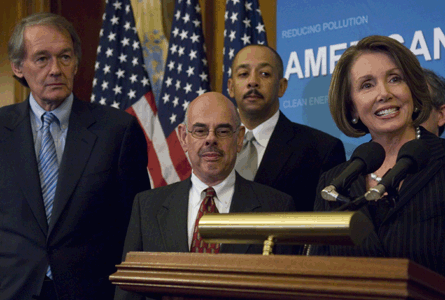Domestic cap and trade legislation has re-emerged on Capitol Hill this year under a Democratic White House set on reforming US energy policy.
Most prominent, and the proposal on which the US House leadership says it will focus, is a draft to establish a tradable permits programme to reduce global warming pollution from aircraft and aircraft engines, oil companies, other modes of transport, electric utilities and large industrial sources of pollution.
Introduced in March by US Representatives Henry Waxman and Edward Markey, The American Clean Energy and Security Act of 2009 also directs the Environmental Protection Agency (EPA) to create emissions standards for new aircraft and new aircraft engines by 31 December 2012. Discussion draft targets also include cutting emissions below 2005 levels by 3% in 2012, by 20% in 2020, by 42% in 2030 and by 83% in 2050.
US airlines see a window of opportunity in notably absent language in the draft to set industry-specific emission goals or the lack of a framework to allocate tradable emission allowances. "We view this as an opportunity to work with them to better shape this bill for the aviation community," Air Transport Association of America (ATA) vice-president of environmental affairs Nancy Young says. She is encouraged that Waxman, chairman of the US House Energy and Commerce Committee, and Markey, chairman of the Energy and Environment Subcommittee, appear open to industry input.
 |
|---|
© Scott Ferrell/Congressional Quarterly/Newsroom |
ALTERNATIVE FUEL INVESTMENT
Members of the US House Energy and Commerce Committee plan to discuss that framework as they complete consideration of the legislation by 25 May. In the meantime, US carriers continue to tout industry investments in alternative fuels. The Air Transport Association of America is reminding legislators that carriers increased fuel efficiency by 110% between 1978 and 2007, and will increase fuel efficiency by another 30% up to 2025.
In addition, the trade group stresses it is concerned that the cap and trade mechanism could drain resources from airlines that otherwise could be used for more energy-efficient aircraft and/or alternative fuels as well as avionics compatible with the next generation (NextGen) air traffic control system. "If you legislate or regulate in a vacuum, you're going to miss a big part of the picture and not necessarily get the right touchstones," Young says.
While the White House has not directly endorsed the draft, President Barack Obama has identified promoting renewable energy sources and reducing dependence on foreign oil as priorities for his administration. When the draft was released, Obama's assistant for energy and climate change, former EPA head Carol Browner, said that while she is still reviewing details, "we support Congress acting now to pass an energy bill that will move the country forward and in the right direction".
The Air Transport Association of America is also closely monitoring carbon tax proposals and US Representative Chris Van Hollen's Cap and Dividend Act of 2009. This sets reduction targets for carbon dioxide emissions, auctions all carbon permits and returns all auction proceeds to consumers via a monthly dividend.
The bill places compliance obligation on the first sellers of oil, natural gas and coal sold in US markets rather than directly on industries. Targets begin with a 25% reduction in CO2 emissions from 2005 levels by 2020 and conclude with an 85% drop in CO2 emissions from 2005 levels by 2050. However, Young says the American Clean Energy and Security Act is the main proposal to watch because House leadership has said it is focusing on the draft.
FAILED ACT
The latest environmental proposals follow last year's failed Lieberman-Warner Climate Security Act, which would have required airlines and other large industries to pay for their emissions. The act failed in the Senate last year after Democratic leaders fell 12 votes short of the 60 votes needed to end a Republican filibuster.
Cap and trade discussions have resumed on Capitol Hill as a proposed endangerment finding for CO2 emissions from vehicles in the USA could open the door for more aircraft regulations under The Clean Air Act.
The EPA issued a proposed finding on 17 April that CO2 and five other greenhouse gases contribute to air pollution that may endanger public health or welfare. The tentative finding could result in new emissions regulations under the Clean Air Act due to a 2007 US Supreme Court decision that the EPA could regulate greenhouse gas emissions if the agency determined they cause or contribute to air pollution that endangers public health.
While the Clean Air Act has aircraft emission standards covering pollutants criteria for air quality in localities, its standards do not address carbon dioxide and other greenhouse gases. Other greenhouse gases in the proposed finding are nitrous oxide, methane, hydrofluorocarbons, perfluorocarbons and sulphur hexafluoride.
Source: Flight International



















